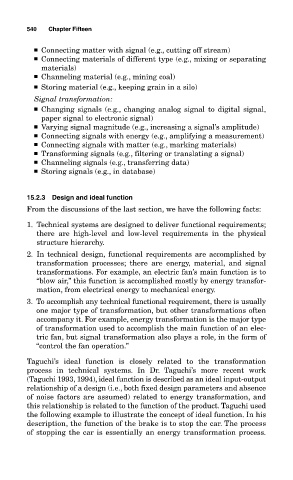Page 583 - Design for Six Sigma a Roadmap for Product Development
P. 583
540 Chapter Fifteen
■ Connecting matter with signal (e.g., cutting off stream)
■ Connecting materials of different type (e.g., mixing or separating
materials)
■ Channeling material (e.g., mining coal)
■ Storing material (e.g., keeping grain in a silo)
Signal transformation:
■ Changing signals (e.g., changing analog signal to digital signal,
paper signal to electronic signal)
■ Varying signal magnitude (e.g., increasing a signal’s amplitude)
■ Connecting signals with energy (e.g., amplifying a measurement)
■ Connecting signals with matter (e.g., marking materials)
■ Transforming signals (e.g., filtering or translating a signal)
■ Channeling signals (e.g., transferring data)
■ Storing signals (e.g., in database)
15.2.3 Design and ideal function
From the discussions of the last section, we have the following facts:
1. Technical systems are designed to deliver functional requirements;
there are high-level and low-level requirements in the physical
structure hierarchy.
2. In technical design, functional requirements are accomplished by
transformation processes; there are energy, material, and signal
transformations. For example, an electric fan’s main function is to
“blow air,” this function is accomplished mostly by energy transfor-
mation, from electrical energy to mechanical energy.
3. To accomplish any technical functional requirement, there is usually
one major type of transformation, but other transformations often
accompany it. For example, energy transformation is the major type
of transformation used to accomplish the main function of an elec-
tric fan, but signal transformation also plays a role, in the form of
“control the fan operation.”
Taguchi’s ideal function is closely related to the transformation
process in technical systems. In Dr. Taguchi’s more recent work
(Taguchi 1993, 1994), ideal function is described as an ideal input-output
relationship of a design (i.e., both fixed design parameters and absence
of noise factors are assumed) related to energy transformation, and
this relationship is related to the function of the product. Taguchi used
the following example to illustrate the concept of ideal function. In his
description, the function of the brake is to stop the car. The process
of stopping the car is essentially an energy transformation process.

